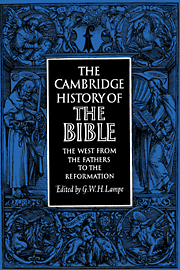Book contents
- Frontmatter
- I The Old Testament: Manuscripts, Text and Versions
- II The History of the Text and Canon of the New Testament to Jerome
- III Early Christian Book-Production: Papyri and Manuscripts
- IV Jerome
- V The Medieval History of the Latin Vulgate
- VI The Exposition and Exegesis of Scripture
- VII The ‘People's Bible’: Artists and Commentators
- VIII Bible Illustration in Medieval Manuscripts
- IX The Vernacular Scriptures
- X Erasmus in Relation to the Medieval Biblical Tradition
- Bibliography
- Notes on the Plates
- Index
- References
IX - The Vernacular Scriptures
Published online by Cambridge University Press: 28 March 2008
- Frontmatter
- I The Old Testament: Manuscripts, Text and Versions
- II The History of the Text and Canon of the New Testament to Jerome
- III Early Christian Book-Production: Papyri and Manuscripts
- IV Jerome
- V The Medieval History of the Latin Vulgate
- VI The Exposition and Exegesis of Scripture
- VII The ‘People's Bible’: Artists and Commentators
- VIII Bible Illustration in Medieval Manuscripts
- IX The Vernacular Scriptures
- X Erasmus in Relation to the Medieval Biblical Tradition
- Bibliography
- Notes on the Plates
- Index
- References
Summary
THE GOTHIC BIBLE
One of the fascinations of the study of the Gothic bible is that it is almost the only literary monument of a race which played so great a part in laying the foundations on which modern Europe eventually arose.
The historian Jordanes relates a popular tradition of about the middle of the sixth century according to which the Goths, leaving Scandza, i.e. the southern part of the Scandinavian peninsula, with a king at their head, arrived by sea at the Vistula delta. One of their branches, the Gepidae who established themselves there a little later, gave the name of Gepidoios to the islands situated at the river mouth. The Goths conquered and dispersed the inhabitants of the coast and also subdued the Vandals who were already established there; and according to Tacitus (Germania 43) and Ptolemy (Geographia 3. 5.20), they remained on the lower Vistula until the middle of the second century A.D.
A new migration took the Goths by stages across the Pripet marshes towards the steppes of the Ukraine and as far as the Black Sea, where their presence is noted in 238. They are then found in Moesia and in Thrace, in contact, and often at war, with the Romans. Finally, certain Goths established themselves within the borders of the empire, north of the Danube and in Dacia (257), while others became mercenaries in the Roman army.
- Type
- Chapter
- Information
- The Cambridge History of the Bible , pp. 338 - 491Publisher: Cambridge University PressPrint publication year: 1969
References
- 5
- Cited by



